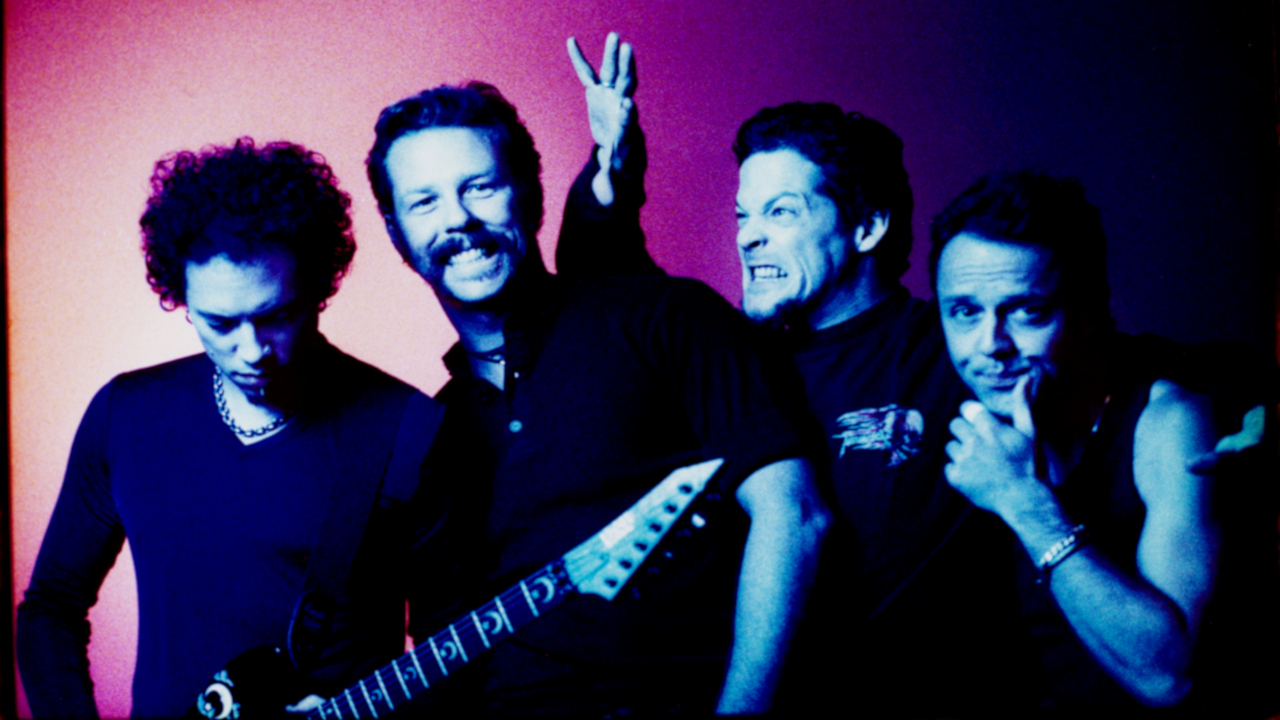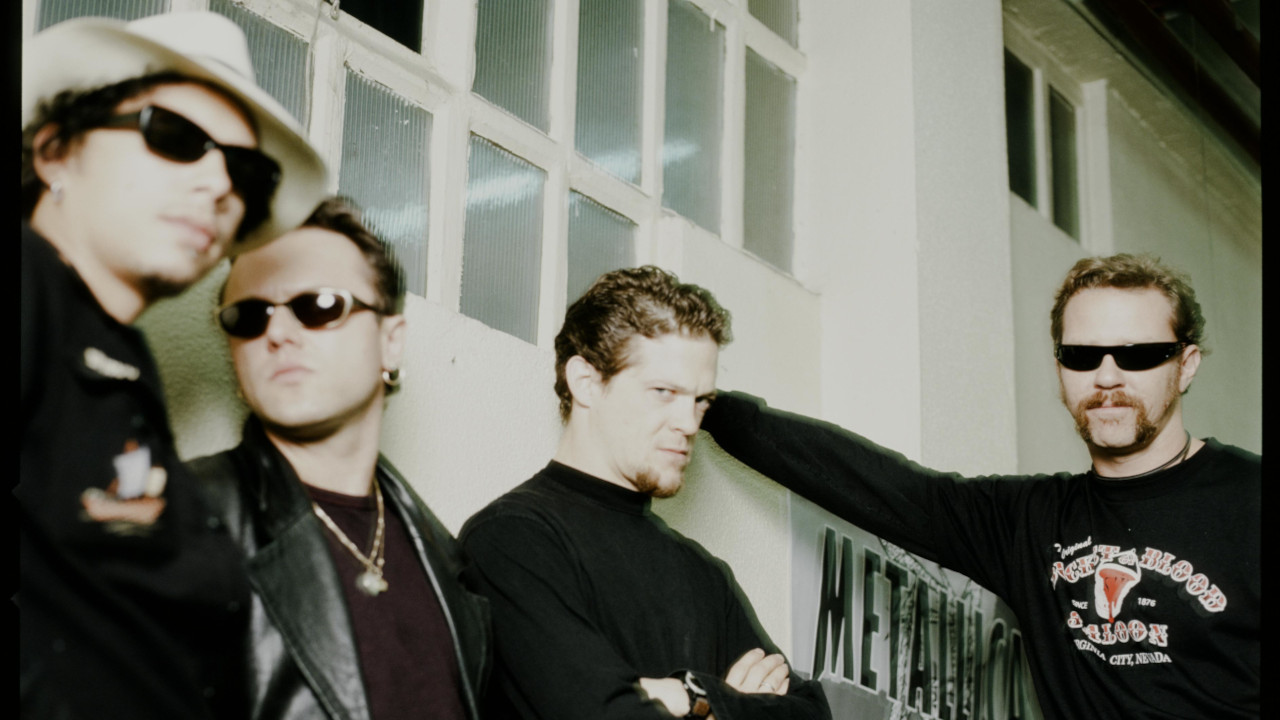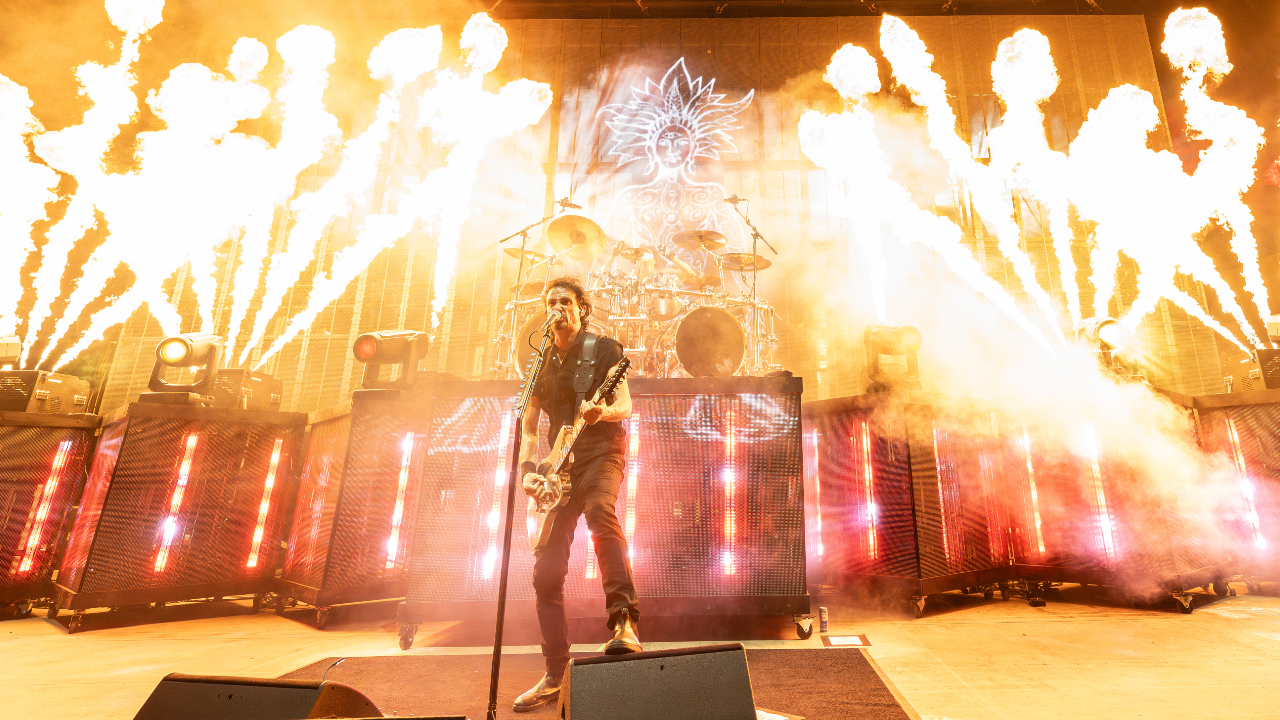"If people think we’re a heavy metal band...I don't really care": how Load and Reload changed Metallica forever
Metallica were already one of the world's biggest bands in the mid-90s. Then came a chapter in their career that'd change many fans' perceptions of them for good

Earl’s Court, London, October 12, 1996. Metallica are playing Enter Sandman to 20,000 baying fans when things start to go spectacularly wrong with their enormous stage set. A roadie high in the lighting rig gets electrocuted and falls from the gantry on the end of a rope. Another catches a flare and goes up in flames, running across the stage as he burns. Suddenly, the entire stage set begins to collapse around the band, and they’re hastily ushered off to safety.
A few minutes later, they come back on and begin playing Am I Evil? through small amps, huddled close together amid the wreckage and lit by bare light bulbs. It’s a headfuck for everyone watching. It takes a few minutes for it to become clear what is happening. This is a stunt, one that will close every show on the 125-date Poor Touring Me jaunt. With the internet still in its infancy, word of this epic prank hasn’t spread. It’s a masterclass in punking an entire audience. Ironically, that’s what some say Metallica did with that year’s Load album and its follow-up, Reload, released 18 months later.
Those two records were a world away from their old thrash metal sound and even more mainstream than the world-beating The Black Album, baffling and enraging a large chunk of their fanbase at the time – a state of affairs compounded by the band’s new, short-hair-and-eyeliner image. Twenty-five years after the release of Reload, that era remains the most contentious period of Metallica’s career.
“One of the most admirable things about the band is they really don’t think in terms of people’s reactions,” says producer Bob Rock, who worked on Load and Reload, as well as The Black Album and 2003’s St. Anger. “They just do what they feel is right for them. They don’t take into account what people think. When they go in a direction and they make a commitment to doing something, they just do it. And they don’t hold back.”
During the 80s and early 90s, Metallica’s ambitions were matched step for step by their success. They swiftly outpaced the thrash metal scene they’d spawned, making the leap from cult underground band to mainstream metal powerhouse. The Black Album’s 10-million-plus sales had put them in music’s top tier alongside the likes of Guns N’ Roses and U2.
“They worked really hard and concentrated on becoming the biggest band in the world, and after The Black Album, they were,” Bob Rock says. “And after you get that, it’s just a different ballgame. I think they felt a certain amount of wanting to stretch out.”
Metallica had barely put a foot wrong over the previous decade, and by the time they wrapped up the massive tour in support of The Black Album, they seemed to be invincible. But even they weren’t oblivious to the musical sea change happening around them. The rise of grunge had precipitated an identity crisis in countless established metal bands, while the genre itself was on the back foot, viewed as a spent force or even an embarrassment in some quarters.
Sign up below to get the latest from Metal Hammer, plus exclusive special offers, direct to your inbox!
“I think they just saw that culture was changing,” says Bob Rock of Metallica’s mindset at the time. “And the rules of metal are very confining. The drum sound has to be a certain way, the guitar sound has to be a certain way, you can’t do harmonies. I mean, that’s just no fun.”
There’s no denying that, but in the run-up to Load Metallica seemed to be split between the traditionalist camp of frontman James Hetfield and bassist Jason Newsted on the one hand, and the more adventurous, experimental leanings of guitarist Kirk Hammett and drummer Lars Ulrich on the other. Kirk was hanging out with his artistic friends in San Francisco, earning himself the in-band nickname ‘Kwirk’ in the process.
“Those guys see me as quirky and unpredictable, because I am more willing to try a lot of things they are a bit hesitant to experiment with,” the guitarist told Metal Hammer at the time. Partner-in-crime Lars, meanwhile, made no secret of his love of Oasis, then the most-talked about band on the planet. “I loved their arrogance, confidence and how every other word would be ‘cunt’ or ‘fuck’,” Lars told the NME. Such was the drummer’s fandom, that he even worked as the Mancunian group’s impromptu lighting engineer at one Oasis show in New Jersey.
While the songs that eventually made up Load and Reload didn’t bear the obvious influence of Noel Gallagher, they did draw from a broader range of influences than ever before: blues rock, Southern rock, country music, biker bar boogie. It showed off a willingness to try something different, even if Bob Rock insists the band didn’t enter the studio with any preconceived ideas in mind.
“There was no conceptual decision that they would go somewhere different,” says the producer. He adds that the most significant change during the sessions that took place throughout the second half of 1995 was that the four musicians worked together in the same room for the first time. “It freed them up from concentrating on what made them who they are. They realised that they could stretch the boundaries and that’s what Load and Reload was.”

Load was released on June 4, 1996, preceded by the single Until It Sleeps (which gave them their very first Top 10 song in the US). Reload, consisting of songs written at the same time as its predecessor that the band simply didn’t have time to record, followed in November 1997. The reception to both was mixed. Some recognised Metallica’s desire to try something different, but many viewed the two records as an unwanted and unnecessary drift towards metal’s middle ground.
Musically, Load and Reload had plenty of high points across their 27 tracks. Until It Sleeps was one of James’s most personal songs, addressing his mother’s battle with cancer, and Reload’s gleefully mutton-headed opener Fuel remains a live staple to this day. Elsewhere, there were some fascinating departures. The Memory Remains has a wonderful gothic twist to it, thanks largely to an inspired guest appearance by 60s singer-turned-art rock doyenne Marianne Faithfull. Mama Said highlighted James Hetfield’s love of country music, and Low Man’s Lyric is a warped-at-the-edges ballad of the sort they’ve never attempted before or since.
Conversely, there was plenty of mid-paced filler amid the 27 tracks that made up the two albums. The stodgy, forgettable likes of Slither, Cure and Thorn Within marked a slip in quality control that wasn’t present on previous Metallica albums. The perception that the band had sold out wasn’t helped by the radical image change they unveiled around the release of Load. The four bandmembers appeared in promotional photos sporting short hair, eyeliner and, in the case of Lars Ulrich, a fur coat – heresy in the world of 90s metal.
The aesthetic overhaul extended beyond haircuts and wardrobes. The self-consciously highbrow covers for Load and Reload were provided by US artist Andres Serrano, based on his controversial artworks Blood And Semen and Piss Christ (the latter featuring a crucifix suspended in a tank of urine). Even their own iconic spiky logo had been ‘de-metalled’. “We were a heavy metal band seven or eight years ago,” Kirk told Metal Hammer in 1997. “I think we started our separation some time around The Black Album.”
It was quite an admission for a group with the word ‘metal’ in their name – one that hinted at an existential crisis in the ranks. Metallica themselves were, of course, bullish in their dismissal of criticism. “If people think we’re a heavy metal band, a Satanic thrash band from Norway or guys that wanna hang around and do all of Oasis’s drugs, I can’t find the energy to defend that,” Lars told Metal Hammer. “I don’t really care.”
While Load and Reload were never going to match The Black Album in terms of sales, their commercial performance was far from disastrous, even if their sales figures (five million and three million in the US respectively) suggested the albums had undeniably lost Metallica a swathe of their following. Tellingly, their first tour in support of Load saw them headlining alt rock travelling circus Lollapalooza (ironically, the festival’s organisers were criticised for booking a ‘metal’ band as headliners).
However, the subsequent Poor Touring Me tour, with its collapsing stage set, played directly to their own fanbase, its success serving as a fuck-you to their critics. Metallica themselves have been critical of Load and Reload in subsequent years. Lars admitted that the world could probably have done “with 12 or 15 less” songs, and Kirk – one of the two chief co-conspirators in the band’s mid-90s shift – put Load last and Reload third from last when ranking their albums in order of quality.
Unsurprisingly, James saw the period around Load and Reload as a misstep in their career. “As far as doing something that doesn’t feel right, I’m sure there’s been a few times that it’s happened – the Load and Reload era, for me, was one of those,” the singer told Clash magazine. “I wasn’t 100% on with it, but I would say that that was a compromise. I said, ‘I’m going with Lars and Kirk’s vision on this. You guys are extremely passionate about this, so I’ll jump on board.’”
While Metallica’s two mid-90s albums are far from perfect, that period stands up far better than its detractors would have it. Trivium frontman Matt Heafy is one of the biggest cheerleaders for Load and Reload. “Anybody who was ever a naysayer of those records back then should re-listen to them now,” he told Loudwire. “The tones of those two records and the tone of [1998 covers album] Garage Inc. – those are some of the best recorded metal albums ever.”
Still, Load and Reload were a watershed for Metallica. It showed that the world’s biggest metal band weren’t infallible. They continued to stretch the boundaries with bold creative decisions, some of which paid off (teaming up with the San Francisco Symphony Orchestra for the original S&M shows), some of which put the controversy surrounding Load and Reload in the shade (that St. Anger snare drum sound; their collaboration with Lou Reed on Lulu).
So what are we to make of Load and Reload 25 years on? The experiment may have been only partially successful, yet far from being the sound of a band selling out, those two albums ultimately reflected Metallica’s desire to move forwards, against the wishes of fans who wanted them to stay exactly the way they used to be. For Bob Rock, it’s simple. “They wanted to grow as a band,” the producer says. “And to give them credit, they’re still around and they’re still huge.”

Paul Travers has spent the best part of three decades writing about punk rock, heavy metal, and every associated sub-genre for the UK's biggest rock magazines, including Kerrang! and Metal Hammer.
